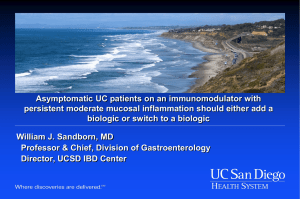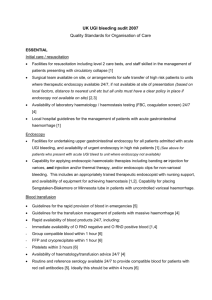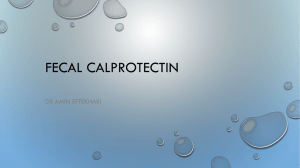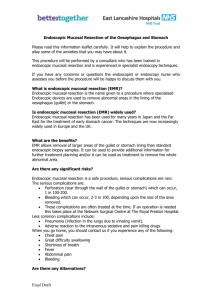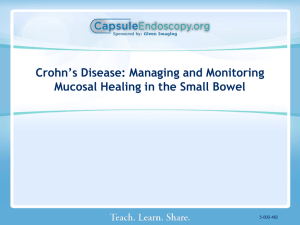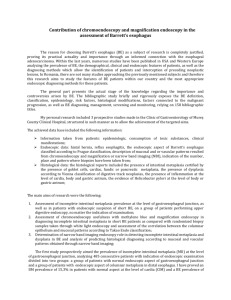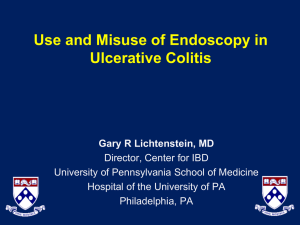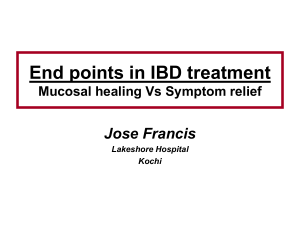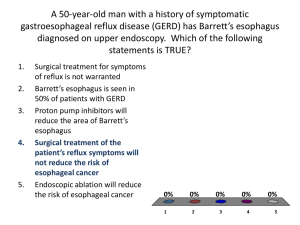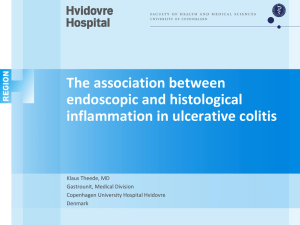What determines “quality” for endoscopy reporting in IBD patients?
advertisement
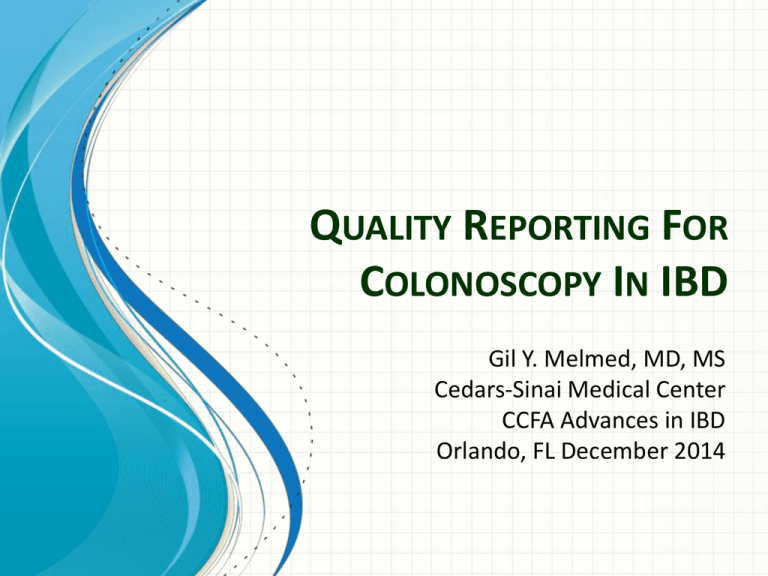
QUALITY REPORTING FOR COLONOSCOPY IN IBD Gil Y. Melmed, MD, MS Cedars-Sinai Medical Center CCFA Advances in IBD Orlando, FL December 2014 Disclosure Gil Y. Melmed, MD, MS I disclose the following financial relationships with commercial entities that produce health care–related products or services relevant to the content I am planning, developing, or presenting: • Consultant: Amgen, AbbVie, Celgene, Given Imaging, Janssen, Luitpold, Takeda, UCB • Research funding: Pfizer, Shire, Prometheus • Clinical trial investigator: AbbVie, Amgen, Celgene, Given Imaging, Hutchison Pharma, Janssen, Pfizer, Takeda Overview • Why are we discussing this? – Variation – Mucosal healing • What is a high quality endoscopy report? • What can we start doing on Monday to improve the quality of endoscopy reporting? What is the purpose of an endoscopy procedure report? • What was done – Type of procedure, interventions, biopsies • Why was it done – Indication for procedure • How was it done – Scope, distance, biopsies – Standardized mucosal description – Perianal description • IBD needs more! – Pre-procedure • Disease phenotype • Current medications • Last procedure – Intraprocedure: • Mucosal inflammation and healing • Disease extent – Postprocedure • Implications • Next steps Improving the Quality of Endoscopy Reporting in IBD • Recommended elements to be included in colonoscopy reports have been proposed by societies, but primarily in the context of colon cancer screening.1,2 • There is little literature and no consensus on what elements constitute a high quality procedure report for patients with IBD 1Rex et al Gastroint Endos 2006 2Armstrong Can J Gastro 2012 Quality Reporting for Colonoscopy (not just IBD) Generic Quality Indicators: Indication for Procedure • Indication for Procedure – Is the procedure indication appropriate? • Up to 40% of endoscopic procedures may be inappropriate – Justify! • • • • Disease monitoring Dysplasia surveillance Exclude infection Assess disease extent • Informed consent Rex AJG 2006 Vader GIE 2000 Variation in Colonoscopy Reporting 438 000 reports Percentage of reports, with information on a prior colon examination for patients who received polyp surveillance, for each practice site. Lieberman et al Gastro Intest Endos 2009; 69: 645-53 Endoscopy for IBD • Critical for management/decision-making • Increased focus on mucosal healing • Dysplasia issues often come back to endoscopic appearance documentation • Despite this, the quality of endoscopic reporting for patients with inflammatory bowel disease is variable Crohn’s Disease Activity Index (CDAI) Clinical Symptoms vs Mucosal Appearance NO CORRELATION! Correlation of CDAI vs CDEIS (N=142) 600 500 400 300 200 100 R=0.13; P=NS 0 0 5 10 15 20 25 30 Crohn’s Disease Endoscopic Index of Severity (CDEIS) Modigliani R et al. Gastroenterology. 1990;98:811-817. 35 Why is Mucosal Healing Important? • In clinical trials, mucosal healing is an important treatment endpoint – Increasingly used in clinical trials – Mucosal healing is a more objective endpoint than clinical remission for evaluating inflammatory disease activity • In clinical practice, mucosal healing can guide medical therapy – Assess disease activity – Growing evidence that mucosal healing is an important goal as it appears to be associated with improved long-term outcomes • Decreased likelihood of a flare • Decreased progression to disease complications • Decreased need for surgery and hospitalization • Decreased risk of dysplasia and colorectal cancer (CRC) de Chambrun GP, et al. Nat Rev Gastroenterol Hepatol. 2010;7:15-29. 11 • Retrospective cohort • 102 patients with active CD • Severe endoscopic lesions (SEL) defined as deep ulcerations >10% of mucosal area with at least one colonic segment • Risk of colectomy associated with SELs, high CDAI, absence of immunosuppression % Colectomy Prognosis of Crohn’s Disease Patients with Severe Ulcerations 62% 42% 31% 18% 8% 6% 1 3 5 Years Allez M, et al. Am J Gastroenterol. 2002;97(4):947-53. What does this tell us about the patients prognosis? You’ve just seen this patient for a second opinion….. Disease Extent Matters (right?) So what does this mean? SES-CD Range: 0-56 Mayo Endoscopic Subscore Normal Colon (0) Moderate Ulcerative Colitis (2) Mild Ulcerative Colitis (1) Severe Ulcerative Colitis (3) Endoscopic pictures courtesy of Gil Melmed, Cedars-Sinai Medical Center Rutgeert’s Score Predicts Post-operative Course Higher endoscopic evidence of inflammation (I3 or I4) indicates a higher risk of clinical symptoms and surgery I0 No lesions I1 < 5 aphthous ulcerations I2 > 5 aphthous ulcerations Diffuse Aphthous ulcerations Large ulcerations, nodules, narrowing I3 I4 Rutgeerts P, et al. Gastro 1990;99:956-963 Reporting Software Love… • Defined fields • Structured data entry • Enhanced communication • Safety reporting • Quality measures • Standardized • Patient portals • Transcription cost saving Hate… • Cumbersome at times • Language often incoherent • Uses classifications systems with no embedded descriptors • Reliance on existing descriptor fields leads to uninformative reports • Use of free text (how fast can you type?) prohibits data searching function • Time / Learning curve UMPIRe Project • Aim: to utilize an evidence-based consensus approach to develop a QUality TeMPlate for IBD Endoscopy Reporting (UMPIRe) – To incorporate the results of UMPIRe into commercially available endoscopy reporting programs • RAND/UCLA appropriateness methodology – A modified Delphi panel iterative approach Methods RAND Methodology Topics: 1. Disease background 2. Findings 3. Dysplasia surveillance 4. Crohn’s disease with anastomosis 5. Pouchoscopy Literature review – 120 proposed elements 1st Round of online voting of 90 proposed elements 51 elements were included in the final content set High Level UMPIRe Results I “Quality Endoscopy Report” • Background information – Disease phenotype – Disease duration (especially if surveillance) – Therapy at the time of exam • Indication – Describe clinical sx’s (asymptomatic? Flare?) – Dysplasia surveillance? – Disease monitoring? High Level UMPIRe Results II “Quality Endoscopy Report” • Procedure details – Maximum extent of exam (TI intubation? A limb?) – If surveillance – technique used • Findings – Descriptors of disease • SES-CD • Mayo (UC) • Rutgeerts score (postop) One example from “the real world…” One example from “the real world…” One example from “the real world…” One example from “the real world…” What does this look like in real life? What does this look like in real life? What does this look like in real life? One example from “the real world…” What can I do next week? • Pick One! – – – – – When was surgery? When last colonoscopy? What drug(s) is patient on? How far into ileum? Rutgeerts score? Summary • Endoscopic appearance of the gut mucosa is one our most important endpoints • Endoscopy reporting for IBD is probably highly variable • Not all elements are required in every procedure • Inclusion of these elements will hopefully improve the quality of reports and improve the quality of care • UMPIRe content being added to commercial endoscopy reporting templates

